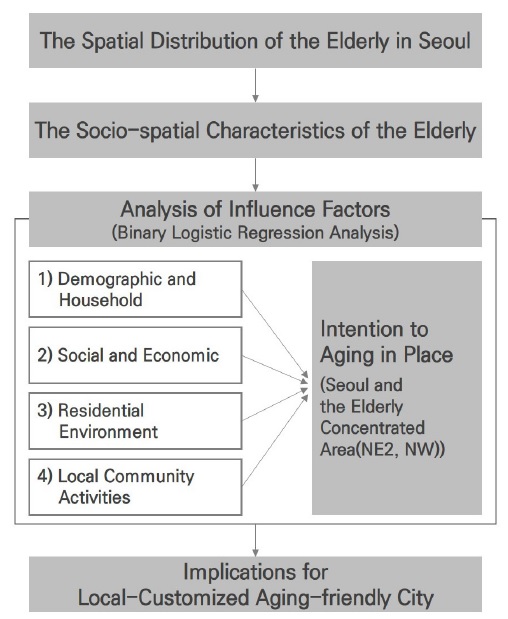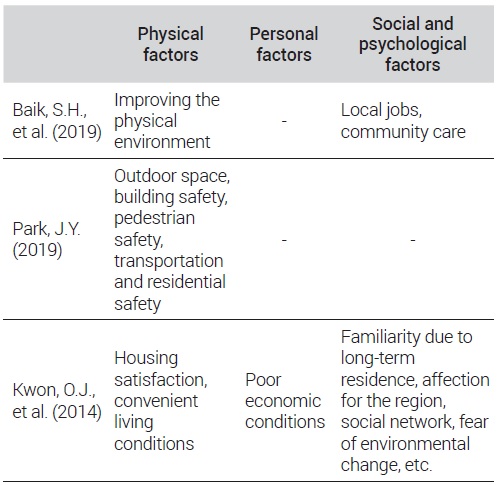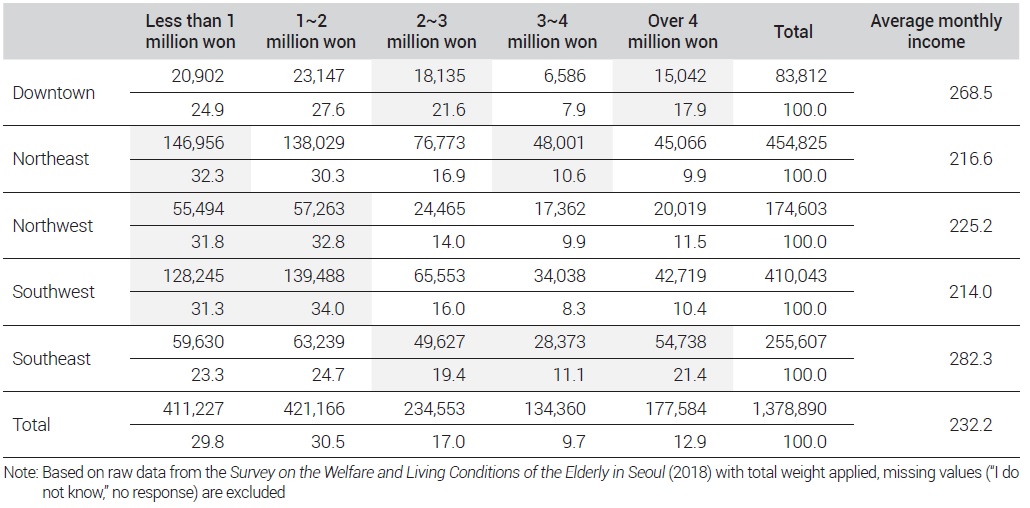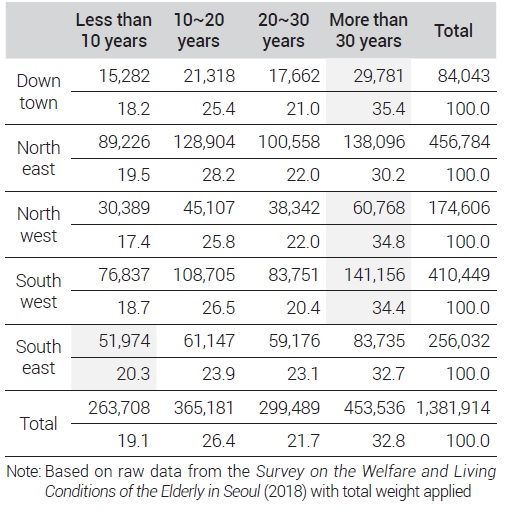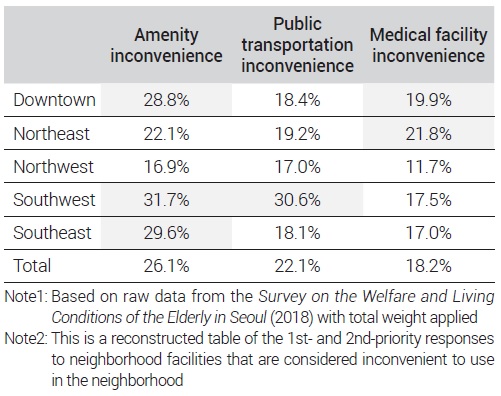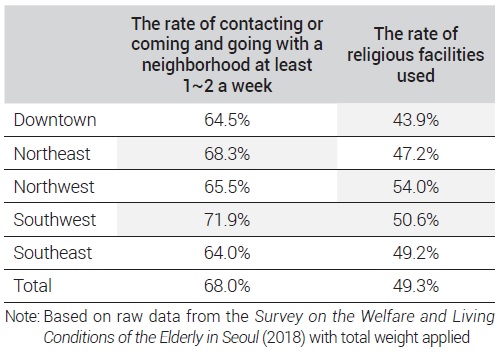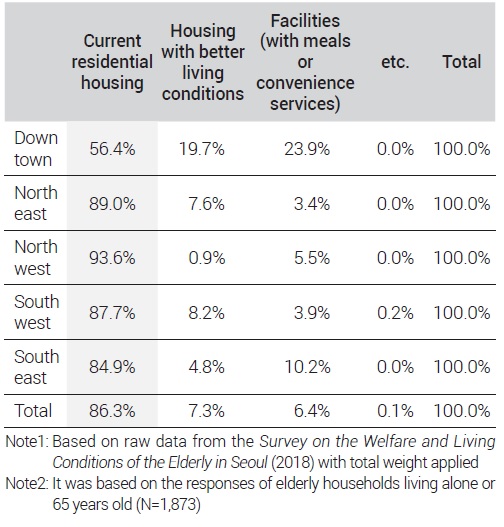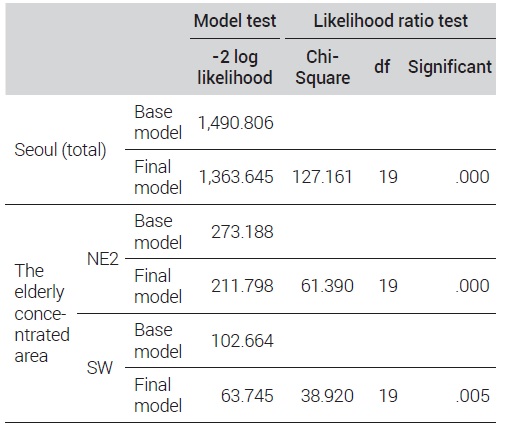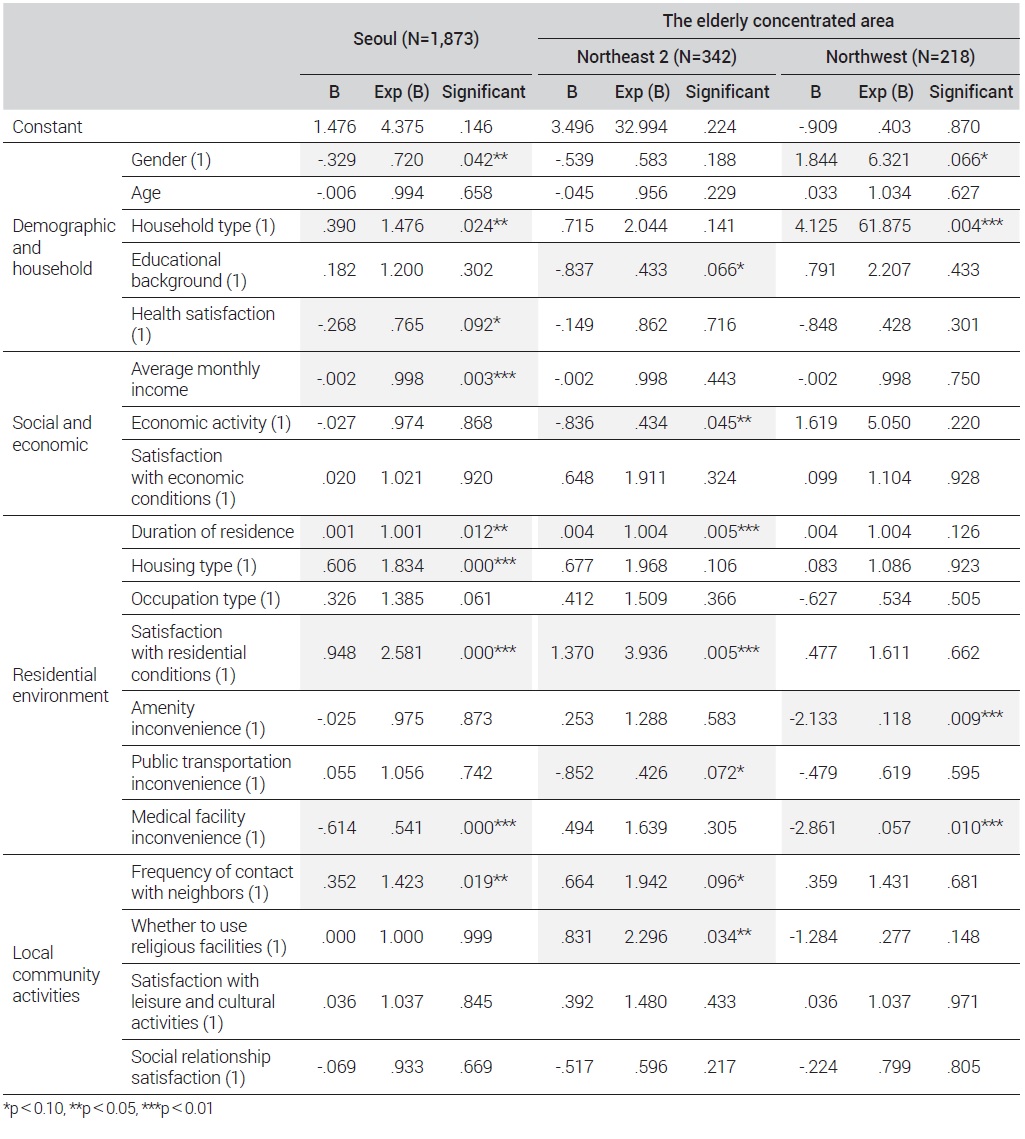
Final publication date 08 Oct 2021
A Study on the Socio-spatial Characteristics of the Elderly and the Influence Factors of ‘Aging in Place’ in Seoul: With a Focus on Elderly-concentrated Areas
Abstract
Seoul’s aging rate is 15.3% (2019), and it is necessary to identify factors for a safe and comfortable “Aging in Place” in the neighborhood for the elderly and support them through local customized policies. The main findings of this study are as follows. The elderly population in Seoul live in the northeastern and northwestern areas and have different socio-spatial characteristics depending on the region. In particular, in areas where the elderly population is concentrated (northeast and northwest), there are many elderly people who are not engaged in economic activities, are aged 75 or older, and have low-income; therefore, policy support is required. Next, not only the personal and housing characteristics of the elderly but also their neighborhood environment and characteristics affect their intention of aging in place. In particular, the convenience to use medical facilities, public transportation, and facilities to live may affect. The factors that affect the aging in place intention of the elderly vary by region; therefore, detailed policy implementation that meets local characteristics is necessary. In particular, it is necessary to improve the neighborhood environment by providing space for community activities or increasing accessibility to public transportation and medical facilities in elderly concentrated areas.
Keywords:
Elderly, Elderly Concentrated Area, Socio-spatial Characteristics, Aging in Place키워드:
고령인구, 고령인구 밀집지역, 사회공간적 특성, 계속 거주, 에이징 인 플레이스Ⅰ. Introduction
1. Research Background and Purposes
In South Korea, population aging has proceeded at a rate unprecedented worldwide. According to Statistics Korea’s data on the Population and Housing Census and the Population Projections, the domestic population aging rate was 15.3% in 2019, thus signaling the nation’s entry into the stage of an aged society with a population aging rate of 14% or above, and, by 2025, the country is expected to enter the stage of a super-aged society where one out of five people are elderly (aging rate of 20% or above). The population aging trend of Seoul is similar to that of the entire nation, and the elderly population of Seoul was 1.376 million in 2019, taking up 15.1% of the total population of the city.
Since 2010, Seoul has responded to dramatic population aging with its age-friendly city policy (Age Friendly Seoul website). Starting with the 2020 Aging Society Master Plan of 2010, the city established the action plan for the first round of the age-friendly city policy in 2012 and jointed the World Health Organization’s (WHO) Global Network for Age-Friendly Cities and Communities (GNAFCC) as a member in 2013. However, the age-friendly city policy of Seoul has tended to be implemented with a focus on the fields of medicine and welfare for vulnerable classes rather than on the improvement of physical environments. The projects of the relevant departments such as the Outreach Community Service Center service and the Care SOS Centers, too, have consisted mainly of those providing individual welfare services to low-income earners and solitary senior citizens. Though projects for the refurbishment of physical environments have partly been pursued as well, most of these have been implemented in a limited manner, in terms of the improvement of indoor environments.
At a point when the population aging rate is predicted to exceed 20% in 2025, it no longer possible to see population aging as an issue limited to particular classes. It is necessary to pursue welfare policies for vulnerable classes through selection and concentration, as has been up to the present, and, at the same time, implement support strategies tailored to the characteristics of each area so that the elderly population may continue to live in the areas of residence safely and comfortably through “aging in place” policies.
In comparison with other age groups, the elderly population is high in the home ownership rate, is low in housing mobility, and has a tendency to live in the areas of their residence for extended periods. The concept of “aging in place” aimed at by the age-friendly city policy likewise aims at enabling the elderly population to lead safe and comfortable lives in their current homes or areas. However, it is not possible to conclude that a given area is safe and convenient for senior citizens’ residence based solely on the phenomenon of the prolonged residence of a large elderly population there. This is because it is difficult to discern whether the reason for the elderly population’s prolonged residence in an area is satisfaction with the residential environment or the difficulty of moving to different homes despite certain inconvenience in the residential environment due to various conditions including income and health (Ko, J.S. and Choi, M.J., 2014). Consequently, it is necessary to review aspects of the current residential environment that are found satisfactory or inconvenient by the elderly population and the effects of such factors on senior citizens’ intention to age in place.
In order to realize Aging in Place, this study focused on the characteristics of areas where the elderly population lives densely and the intention to aging in place. Accordingly, the three following research questions were established, and the socio-spatial characteristics of the elderly population and the factors affecting senior citizens’ intention to age in place were verified, with a focus on elderly-concentrated areas:
First, mainly in which areas of Seoul do senior citizens live in concentration, and what are the socio-spatial characteristics of the elderly population per area?
Second, what are the factors affecting the intention to age in place harbored by senior citizens in Seoul?
Third, in what aspects do the factors influencing the intention to age in place harbored by senior citizens in elderly-concentrated areas such as the northeast and the northwest differ from those for the elderly population throughout Seoul?
Here, “elderly-concentrated areas” were defined as areas that were high in both the number and ratio of senior citizens. Influence factors were grasped, with a focus on the northeast2 and the northwest that matched this definition, and comparatively analyzed with those for the entire city. The purpose of this study lies in grasping, through such tasks, the factors affecting the intention to age in place harbored by senior citizens both throughout Seoul and in elderly-concentrated areas within the city and presenting implications for the direction of the age-friendly city policy that will take regional characteristics into consideration.
2. Research Scope and Methodology
In this study, with senior citizens aged 65 or above living in Seoul as the objects, elderly-concentrated areas were confirmed through the distribution of senior citizens per administrative dong (neighborhood). For this, data from the 2015 Population and Housing Census (Statistics Korea) were used to grasp the number of elderly people and the current status of their distribution, with the populations aging rate as the criterion.
In addition, raw data from the 2018 Survey on the Welfare and Living Conditions of the Elderly in Seoul (released by the Korea Social Science Data Archive) were used to analyze the demographic/household characteristics, socioeconomic characteristics, residential environments, participation in local communities, and the intention to age in place harbored by the elderly population in Seoul and the socio-spatial characteristics of senior citizens in elderly-concentrated areas and those of their peers throughout Seoul were compared. The Survey on the Welfare and Living Conditions of the Elderly in Seoul have been conducted every two years since 2012 based on the Seoul Metropolitan Government Framework Ordinance on Realization of Age-Friendly City (also known as the Basic Senior Welfare Act for the Construction of an Age-Friendly Seoul City). The city government has announced the results of the survey on the overall daily lives of the elderly population, and the 2018 survey was conducted on 3,034 senior citizens aged 65 or above living in Seoul.
Next, the factors affecting the intention to age in place harbored by the elderly population in Seoul were grasped, and whether or not the influence factors were disparate according to regional characteristics. Analysis was conducted on the elderly-concentrated areas in the city (northeast2 and the northwest), and binomial logistic regression analysis was conducted using the SPSS Statistics program.
Ⅱ. Literature Review and the Establishment of the Analytical Framework
1. The Elderly Population’s Residential Choices and Theories on Aging in Place
Residential choices are closely related to aspects such as the characteristics of households, which are the decision-making units of housing mobility, physical characteristics of housing, and surrounding environments. Under capitalistic mechanisms, choices regarding housing mobility are inevitably affected by satisfaction with the current residential housing and the socioeconomic characteristics of the given population or households including life cycles, educational processes, occupations, number of household members, income, housing characteristics, occupation type, residential level, housing type, surrounding characteristics, and development status of the areas.
The elderly population’s residential choices can be affected in a complex manner by changes stemming from the life cycle, age or health status, marital status, and socioeconomic conditions. Wiseman (1980) has classified senior citizens’ residential mobility into three types: an amenity move, where one moves for a comfortable daily life and convenience after retirement; an environmental push, where one moves for affordable housing or good neighbor relations; and an assistance move to obtain help from those around oneself due to issues such as health. Similarly, Meyer and Speare (1985) have classified the elderly population’s residential mobility into amenity mobility, assistance mobility, and mobility in preparation for aging. Out of them, an amenity move is related to residential mobility, which senior citizens choose voluntarily to raise convenience in their daily lives. This implies that not only individuals’ socioeconomic characteristics but also the possibility of or satisfaction with using the local neighborhood environments and daily convenience facilities can affect the elderly population’s residential choices and, moreover, aging in place.
“Aging in place” signifies senior citizens’ continued, safe, and comfortable residence in places they have lived thus far, or their familiar homes or local communities, regardless of individual income levels or health status. Because the elderly population can secure spatial and social continuity in places that they have lived in and live independently through aging in place, this can ultimately contribute to the raising of senior citizens’ quality of life and these people’s active lives in old age (Seo, Y.J., 2018; and Park, J.Y., 2019).
In order to realize aging in place, senior citizens themselves must wish to continue residence in local communities and be buttressed by diverse support programs and the creation of age-friendly neighborhood environments in local communities. When such conditions are not met, senior citizens will come to feel inconvenience or difficulty in daily life despite the familiarity of the environments and may be reduced in activities in everyday life (Kwon, O.J. and Kim, J.Y., 2019).
In the past, up to the 1960s, major countries’ population aging policies perceived aging as a special social issue or viewed the elderly population as socially vulnerable, aiming at the institutionalization of senior citizens (Joo B.H., et al., 2019). As social perceptions of aging and the elderly began to change, however, the need for aging in place emerged instead of institutionalization, which drastically changed senior citizens’ residential environments and incurred considerable social costs.
The concept of “aging in place” was first mentioned in the Vienna International Plan of Action on Aging adopted at the United Nations’ (UN) 1st World Assembly on Aging held in 1982 (United Nations, 1982; Lee, Y.K., et al., 2017). Though the plan did not directly mention the term “aging in place,” it included contents on aging in place in local communities by stipulating “to enable [the elderly] to lead independent lives in the community for as long as possible” (Recommendation 9) among the basic principles of giving care to senior citizens. In recent years, the discussion has developed “aging in place” and proceeded to include “aging in community,”1) which stresses local communities.
Amidst such responses, the WHO has pursued the GNAFCC project since 2006 in order to establish international joint responses to the worldwide trends of population aging and urbanization and to support individual cities’ establishment of countermeasures. Membership in the network is based on the level of cities or regions, and, as for South Korea, a total of over 20 local governments including Seoul, which became a member in 2013, have joined as member cities.
Presented in 2007, the age-friendly city guidelines (WHO) proposes the establishment of an age-friendly city action plan based on eight spheres such as “social participation,” “respect and social inclusion,” “civic participation and employment,” “communication and information,” and “community support and health services” including “outdoor spaces and buildings,” “transportation,” and “housing” in terms of the physical environment. These guidelines stress that it is important to create age-friendly residential environments such as neighborhood facilities and public transportation in local communities for senior citizens’ active lives in old age and necessary to raise the elderly population’s quality of life by expanding caregiving services and opportunities for participation in local communities and social and leisure activities.
2. Literature Review
Existing studies on the elderly population’s intention to age in place mostly focus on the provision of welfare services or on welfare facilities and indoor residential environments and therefore consist mainly of research in the fields of social welfare or architectural design. With further population aging and the activation of discussions on aging in place in recent years, however, the tendency has been for the objects and scope of studies to expand increasingly to the field of urban planning such as physical outdoor environments and living conditions.
Accordingly, with a focus on research conducted since 2010, existing studies were largely classified into the two types of 1) those on the distribution and characteristics of the elderly population in Seoul and 2) those on senior citizens’ aging in place. When the contents of these studies are summarized, they are as follows.
As for studies analyzing the distribution and characteristics of the elderly population in Seoul proper or the greater Seoul metropolitan area, there are those by Lee, H. Y., et al. (2015), Jeong, J.E. and Jun, M.J. (2013), and Park, S.N. (2019), among others.
Research by Lee, H.Y., et al. (2015) focuses on low-income senior citizens and certifies the distribution of and changes to the low-income elderly population by using 2000-2010 data on the level of census output areas. According to the analysis, low-income senior citizens mainly live in the Gangbuk area (area to the north of the Han River), and areas concentrated with these people increasingly tend to become fixed. These areas can be classified into categories such as areas concentrated with detached houses and multi-household houses on hilly land, housing-concentrated areas around stations in the old city center, and permanent rental apartments according to their physical characteristics.
Jeong, J.E. and Jun, M.J. (2013) have extracted “elderly-concentrated areas,” with the ratio of the elderly population per 2010 census output area in the greater Seoul metropolitan area (41,437) as the standard, grasped the spatial distribution of senior citizens in the greater Seoul metropolitan area, and analyzed the demographic, housing, social (elderly facilities), and locational characteristics of this area. Through this, this study classifies elderly-concentrated areas in the greater Seoul metropolitan area into the two types of areas near the downtown in the Gangbuk area such as Jung-gu in Seoul and rural areas outside the greater metropolitan area. The elderly-concentrated areas extracted in this study are high in the ratios of widowed or divorced households and small-scale aged housing but low in accessibility to leisure and welfare facilities.
Meanwhile, according to a study by Park, S. N. (2019), the characteristics of socioeconomic activities performed by senior citizens in Seoul differ per not only gender, age, and housing type but also residential area. It is possible to confirm that while the elderly population in the three gu (districts) of the Gangnam area (Gangnam-gu, Seocho-gu and Songpa-gu) is higher in the ratio of engagement in social activities than in the ratio of engagement in economic activities, senior citizens in the downtown or the northeast have a relatively lower ratio of engagement in social activities.
When the contents of existing studies on the distribution and characteristics of the elderly population are synthesized, senior citizens in the city display physically and socioeconomically disparate characteristics per area of residence. The area mainly inhabited by the elderly population of Seoul is the Gangbuk area, which can be classified into categories such as low-income residential areas on hilly land, areas adjacent to the downtown, and permanent rental apartment complexes in terms of the physical aspects. The Gangbuk area exhibits the characteristic of a relatively high ratio of both low-income senior citizens and the working elderly population in terms of socioeconomic activities as well, thus forming a contrast with the Gangnam area, where social activities including leisure activities thrive.
According to Wiseman (1980), whether or not the elderly population migrates or does not move is affected by factors promoting or impeding housing mobility and is realized through a complex decision-making process. In order to support senior citizens’ aging in place, it is necessary to grasp comprehensively the influence of physical environments on the local level and satisfaction or inconvenience regarding neighborhood facilities experienced by the elderly population in daily life on these people’s intention to age in place in addition to the elderly population’s socioeconomic aspects. When related earlier studies are examined from this perspective, they are as follows (Table 1).
As for recent research on Seoul’s age-friendly city policy, representative is a study by Baik, S.H., et al. (2019). This study selected two case areas in Seoul and conducted a survey of the residents on their health status, economic status, and social relationships, thus grasping local demands for improvements in the WHO’s eight spheres. According to the results of the analysis, the need for opportunities to participate in local jobs or local activities and for safe pedestrian environments was high. Accordingly, this study argued that, in order to realize aging in place, it was necessary to go beyond existing welfare and health services and to expand the scope of policies to increased jobs for senior citizens and improved physical environments. In addition, considering that everyday physical activities are an indispensable element to healthy old age, the study elucidated the need to grasp senior citizens’ actual movement flows, daily lives, and needs and to improve living environments from local perspectives.
A study by Park, J.Y. (2019) analyzes the relationship between physical safety and the elderly population’s aging in place in five sub-regions of Seoul. The physical safety of urban environments is classified into categories such as outdoor spaces and buildings, pedestrian safety, transportation safety, and housing safety and the current status is grasped per area, and, through a survey of the elderly population of Seoul, the correlation between the degree of the perception of the safety of one’s residential area and the intention to age in place is analyzed. According to the results of the analysis, the intention to age in place harbored by senior citizens in Seoul was 78.6%, thus being high, and overall physical safety including outdoor spaces, building safety, pedestrian safety, transportation safety, and housing safety was confirmed to be stronger in areas where the elderly population had a strong intention to age in place such as the northwest and the southeast.
Kwon, O.J., et al. (2014) have analyzed the reasons for and contents related to senior citizens’ wish to age in place by using the qualitative research method on 17 people (nationwide distribution) aged 60 or above who wished to age in place in their respective areas. According to the results of in-depth interviews, the main reasons for senior citizens’ wish to age in place were investigated to include familiarity stemming from prolonged residence, affection for given areas, housing satisfaction, convenient surrounding living conditions, and human networks. In contrast, certain respondents wished to age in place due to fear of changes to their environments or the lack of the economic means to afford moving costs despite a situation where the current housing conditions were inappropriate for them. Accordingly, the study argues that it is necessary to reduce senior citizens’ psychological and social instability by providing alternative housing or service housing per area and to provide support for aging in place.
As has been examined above, with the development of population aging in South Korea, both quantitative and qualitative studies have been conducted in order to create age-friendly environments or to present the direction of policies for aging in place. In relation to the distribution and characteristics of senior citizens, they grasp the distribution and current status of elderly-concentrated areas through analyses on the level of census output areas or elucidate the physical and sociodemographic characteristics of these areas. As for studies related to the intention to age in place, they grasp relations of influence on physical, individual, and sociopsychological levels, with a focus on the entire nation or case areas.
However, insufficient are studies that examine the socio-spatial characteristics of the elderly population, with the entire Seoul as the object, and verify the effects of such characteristics on senior citizens’ intention to age in place and regional differences in such influence factors. Studies tend to be limited in their contents to physical environments or housing and demographic/household characteristics or limited spatially to particular case areas or samples.
In this study, with a focus on both Seoul and elderly-concentrated areas within the city, factors influencing senior citizens’ aging in place were analyzed to verify factors that were noteworthy in terms of elderly-concentrated areas as opposed to the entire city. The study is differentiated in that, through such tasks, it presents implications for the creation of age-friendly neighborhood environments that take regional characteristics into consideration.
3. The Establishment of the Analytical Framework
This study largely consists of the three following aspects: the spatial distribution of the elderly population in Seoul; an analysis of the socio-spatial characteristics of these people; and an analysis of factors influencing these senior citizens’ wish to age in place (Figure 1).
First, the current status of the elderly population of Seoul was grasped per area. To achieve this, data from the 2015 Population and Housing Census were used to construct data on the current status of senior citizens aged 65 or above per administrative dong. Administrative dong with a number of senior citizens equal to or above the average for all dong (2,880) and a population aging rate of 14% or above were extracted in order to verify areas in which the elderly population of the city was mainly concentrated. Through this, the fact that senior citizens were concentrated in the northeast and the northwest, areas of focus in this study, was confirmed.
Second, the socio-spatial characteristics of the elderly population in both Seoul and areas within the city were grasped. As for the analysis of socio-spatial characteristics, data from the 2018 Survey on the Welfare and Living Conditions of the Elderly in Seoul, where investigations were conducted on senior citizens aged 65 or above living in the capital, were used. Spatially, characteristics were analyzed on the level of areas than on that of individual local governments,2) and, in particular, analysis was conducted with a focus on the socio-spatial characteristics of the northeast and the northwest, which are elderly-concentrated areas, in comparison with those of the entire city. Through this, the differentiated characteristics of senior citizens living in elderly-concentrated areas in terms of health status, economic status, residential environments, and local communities were confirmed.
Third, based on the socio-spatial characteristics of senior citizens analyzed above, factors affecting the intention to age in place harbored by the elderly population of Seoul were grasped. The objects were the 1,873 cases with responses to the question regarding the intention to age in place from data on the 2018 Survey on the Welfare and Living Conditions of the Elderly in Seoul, and binary logistic regression analysis was used. In particular, with a focus on the northeast2 and the northwest, all of which are elderly-concentrated areas, influence factors of the intention to age in place were classified into ① demographic/household characteristics, ② socioeconomic characteristics, ③ residential environments, and ④ activities in local communities and analyzed, the results of which were compared with the figures for Seoul.
In relation to the demographic/household characteristics and the socioeconomic characteristics that can affect the elderly population’s intention to age in place, existing studies have elucidated as influence factors aspects including health status, household type, income level, and economic status according to changes to senior citizens’ life cycles. This study added and analyzed aspects such as satisfaction with health status and with economic status felt by senior citizens in daily life besides individual factors elucidated by earlier research.
Meanwhile, this study took note of the effects of both residential environments and participation in local community activities on senior citizens’ wish to age in place in addition to these people’s demographic/household characteristics and socioeconomic characteristics. According to earlier research, it is very important for the elderly population to feel physical comfort and psychological stability in areas of residence. Consequently, it was necessary to grasp aspects such as the elderly population’s feelings regarding neighborhood environments and the degree of their participation in activities in local communities.
As residential environments, aspects such as satisfaction with residential status and inconvenience in using convenience facilities, public transportation, and medical facilities in daily life felt by the elderly population were grasped in addition to the duration of residence, housing type, and occupation type. While earlier research conducted analysis with a focus on the current status of physical facilities or on safety, this included among the items analyzed convenience (or inconvenience) in using neighborhood facilities as felt by senior citizens.
In relation to participation in local community activities, aspects such as the frequency of contact with or visits to neighbors, use of religious facilities, satisfaction with one’s own leisure and cultural activities, and satisfaction with social relationships with friends and neighbors were analyzed. Through this, community activities in which senior citizens can participate voluntarily on the local level were analyzed to confirm whether or not local communities could have positive effects on strengthening the elderly population’s wish to age in place.
Ⅲ. The Distribution and Socio-spatial Characteristics of the Elderly Population of Seoul
1. The Current Status of the Distribution of the Elderly Population of Seoul per Area
As per data from the 2015 Population and Housing Census, the elderly population of Seoul amounts to around 1.222 million, taking up 12.3% of the city’s total population. When examined per area, the downtown and certain parts of the southeast have relatively small numbers of senior citizens while concentrated in the northeast, northwest, and southwest are administrative dong with numbers of senior citizens equal to or above the average for all dong (2,880). It is possible to confirm that there is a large elderly population, with a focus on Hwagok 1-dong (6,169) in Gangseo-gu, Yeokcheon-dong (6,142) and Bulgwang-dong (5,909) in Eunpyeong-gu, Junggye 2-dong/Junggye 3-dong (5,906) and Sanggye 3-dong/Sanggye 4-dong (5,787) in Nowon-gu (Yang, J.S. and Seong, S.Y., 2020) (Figure 2).
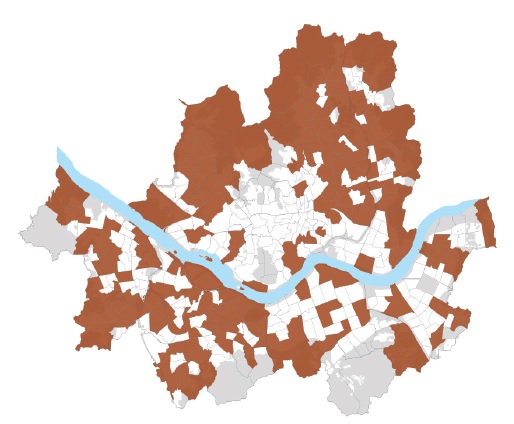
The status of administrative dong above the average number of elderly in Seoul (2015)Note: Based on the average number of elderly people by administrative dong (2,880); The gray shade represents the green zoneData source: Statistics Korea, 2015, Population and Housing Census
Meanwhile, the average population aging rate per dong was 12.6% in 2015, displaying a tendency different from that of the spatial distribution of the elderly population. The distribution of administrative dong with a population aging rate of 14% or above is as in the diagram below and was concentrated mainly in the downtown and the northeast. The top five administrative dong with high population aging rates were Samcheong-dong in Jongro-gu (20.4%), Cheongnyangni-dong in Dongdaemun-gu (19.8%), Suseo-dong in Gangnam-gu (19.8%), Beon 3-dong in Gangbuk-gu (19.8%), and Dobong 1-dong in Dobong-gu (19.8%) (Figure 3).
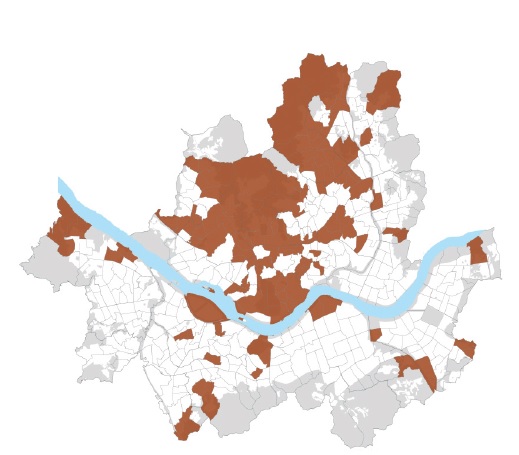
The status of administrative dong with an aging rate of 14% or higher in Seoul (2015)Note: The gray shade represents the green zoneData source: Statistics Korea, 2015, Population and Housing Census
Out of 424 administrative dong in Seoul, areas that are high in both the number of senior citizens and the population aging rate are concentrated in the northeast (Gangbuk-gu, Seongbuk-gu, Dobong-gu) and the northwest (Eunpyeong-gu, Seodaemun-gu). Administrative dong whose number of senior citizens and population aging rate both are equal to or above the averages amount to a total of 130, with the elderly population living in these areas amounting to a total of 509 thousand and taking up approximately 42% of the total number of senior citizens in the city (1.22 million). The average number of senior citizens and the average population aging rate were 3,910 and 14.3%, respectively, for these 130 administrative dong, and these figures are higher than the averages for the entire city by 1.4 times and 1.2 times, respectively. Next, the socio-spatial characteristics of the elderly population in Seoul were examined and analyzed per area, with a focus on the northeast and the northwest, where senior citizens live in concentration.
2. The Socio-spatial Characteristics of the Elderly Population of Seoul
Based on data on the 2018 Survey on the Welfare and Living Conditions of the Elderly in Seoul as the standard,3) the elderly population of the city amounted to a total of 1.38 million, out of whom 55.8% were females and 44.2% were males, with females taking up a relatively larger proportion. As for age groups, 830 thousand constituted the early elderly population aged 65-74, who took up 60% of the total senior citizens living in Seoul. The late elderly population aged 75 or above amounted to 552 thousand, taking up approximately 40% of the total senior citizens in the city. In particular, the northeast (41%) and the northwest (43%) areas were high in the ratio of the late elderly population(Table 2).
As for household types, single-person households amounted to 310 thousand, taking up 22.4% of the total elderly households. Households consisting of senior citizens aged 65 or above amounted to 544 thousand, thus taking up the greatest share (39%), and households where senior citizens lived together with other members such as children took up 38%. The ratio of single-person households was the highest for the downtown, amounting to 28.2%, and the lowest for the southeast, amounting to 19.4%. It was 22.6% and 22.9% for the northeast and the northwest, respectively, thus exhibiting levels similar to that of the average for the entire city. Meanwhile, the ratio of highly educated senior citizens (high school graduates or above) took up 38.3% of the total, and the figures for the northeast (33.3%) and the northwest (38.9%) were similar to or lower than the average for Seoul.
Next, the socioeconomic characteristics of the elderly population of Seoul were grasped. As for the economic aspect, 35.1% of the total respondents replied, “I currently work,” thus showing that one out of three senior citizens continued to engage in economic activities. In addition, the answer “I have worked before but do not work now” took up 49.6% of the total, and the answer “I have never worked all my life” took up 15.3% of the total, respectively. The ratio of senior citizens performing economic activities was 33.7% for the northeast and 33.3% for the northwest, respectively, with the proportion of the elderly population participating in economic activities smaller in comparison with other areas.
Combining earned income, business income, pensions, and property income, the average monthly household income of the elderly population of Seoul amounted to 2.32 million won (Table 3). Households with an average monthly income of 2 million won or below exceeded 60% of the total households so that senior citizens with below-average income took a greater share of the total.4) In particular, the ratio of low-income senior citizens (1 million won or below) was considerable, amounting to 30% or above, with a focus on the northeast and the northwest.
The elderly population exhibited housing characteristics differentiated from those of other age groups in terms of life cycles. Senior citizens were relatively low in the rate of residence in apartments and high in the rate of residence in detached houses and multi-household houses. As for the elderly population’s housing types, apartments took up 40.7% of the total, followed by detached houses and multi-unit houses (31.9%) and tenement houses and multi-household houses (26.5%), in this order. This differed from data from the 2015 Population and Housing Census: from among the total of 2.793 million units of housing in Seoul, apartments took up the greatest share of 58.6% (1.637 million units), followed by tenement houses and multi-household houses (27.6%; 772 thousand units) and detached houses (12.7%; 355 thousand units), in this order. Out of individual areas, the ratio of detached houses and multi-unit houses was relatively high (39.1%) in the northeast while that of tenement houses and multi-household houses (32.5%) was high in the northwest.5)
The home ownership rate of the elderly population was 72.4%, a relatively very high level when considering that, with the 2020 Korea Housing Survey as the standard, the home ownership rate for the entire city amounted to 42.2%. As for individual areas, the figures were equal to or above the average for Seoul for the northeast (73.7%) and the northwest (73.6%), and the home ownership rate was relatively low (66.6%) in the southeast.
Meanwhile, the elderly population tends to be low in mobility in comparison with other age groups such as general households and youths. According to the results of the 2020 Korea Housing Survey, the duration of residence in the current housing only amounted to an average of 1.8 years for young households aged 39 or below but amounted to an average of 12.2 years for elderly households aged 65 or above. When examined per the duration of residence, senior citizens living in the same areas for 20 years or more exceeded the half, with those whose duration of residence amounted to 30 years or more taking up 33% of the total as well. As for individual areas, the ratio of the duration of residence amounting to 30 years or more was high in the downtown and the northwest (Table 4).
Because the elderly population experiences reduced physical functions in terms of life cycles, their use of neighborhood facilities is inevitably reduced, unlike the case of youths, and, according to a study by Kim, Y. J. (2012), the limit distance only amounts to around 250-400 m. Consequently, neighborhood environments in local communities or near homes invariably have even more important effects on senior citizens’ quality of life. As in<Table 5>, aspects found dissatisfactory by the elderly population in using major neighborhood facilities in the areas of their current residence were grasped, the results of which were high, in the order of inconvenience in using convenience facilities (26.1%), inconvenience in using public transportation (22.1%), and inconvenience in using medical facilities (18.2%).
As for individual areas, the ratio of dissatisfaction with the use of medical facilities was high but that of dissatisfaction with the use of convenience facilities and public transportation was low in the northeast. In the northwest, most responses fell below the averages, thus showing that inconvenience in using local neighborhood facilities was not great in comparison with other areas.
For senior citizens to wish to age in place, neighborhood environments and local community services must be provided, and also necessary along with them is social support (Kwon, O. J. and Kim, J. Y., 2019). Here, in order to grasp the degree of the elderly population’s participation in local communities, the frequency of these people’s contact with or visits to neighbors was grasped, and their use of religious facilities, which were expected to play an important role in maintaining senior citizens’ communities, was examined (Table 6).
The ratio of respondents stating that they frequently visited neighbors, 1-2 times per week or more, amounted to 68.0%, the highest in the southwest (71.9%) and followed by the northeast (68.3%) and the northwest (65.5%), in this order, in terms of areas. The religious facility use ratio amounted to 49%, being high in the northwest (54.0%) and the southwest (50.6%) in terms of areas. Religious facility use rates were relatively low in the northeast and the downtown.
Meanwhile, the results of an analysis of satisfaction felt by senior citizens in daily life with their health status, economic status, social, leisure, and cultural activities, and housing status are as in <Table 7>. Answers that the respondents were satisfied with their social relationships (62.5%) and housing status (52.9%) were the highest, followed by satisfaction with their health status (46.4%) and leisure and cultural activities (39%), in this order. Replies that the respondents were satisfied with their individual economic status were the lowest, amounting to 25.8%.
When satisfaction with daily life per area is compared with that for all of Seoul, senior citizens in the northeast were relatively high in satisfaction with their social relationships and housing status but low in satisfaction with their health, economic status, and leisure and cultural activities. The elderly population in the northwest overall exhibited a level of satisfaction similar to or somewhat lower than the average level of satisfaction felt by of senior citizens throughout Seoul.
3. Conclusion
The elderly population of Seoul lived mainly in the northeast, northwest, and southwest, and population aging rates were high in the Gangbuk area including the downtown, northeast, and northwest. 42% of the total elderly population of the city lived in so-called “elderly-concentrated areas,” which were high in both the number of senior citizens and the population aging rate, and these areas mainly overlapped with the northeast and the northwest.
As for the elderly population of Seoul, the rate of residence in non-apartments such as detached houses, tenement houses, and multi-household houses (58%) and the home ownership rate (72%) were both high. In addition, there was a clear tendency to live for prolonged periods in their current areas of residence (20 years or more: 54.5%). When examined in detail, however, senior citizens displayed disparate socio-spatial characteristics per area. Not only objects aspects such as age and income but also satisfaction with daily life and inconvenience felt in using neighborhood facilities in local communities were confirmed to differ per area.
High in both the number of senior citizens and the population aging rate, the northeast and the northwest exhibited high rates of visits to neighbors, thus making it possible to make the interpretation that local communities have been formed comparatively well in these areas. However, these areas were high in the ratios of senior citizens not engaged in economic activities, late elderly population aged 75 or above, and low-income senior citizens (monthly income of 1 million won or below) as well. In addition, the elderly population here was low in satisfaction with individual health, economic status, and leisure and cultural activities also. When the results of the analysis are synthesized, in order to realize the elderly population’s aging in place in Seoul, it is necessary to prioritize “elderly-concentrated areas,” where senior citizen who are socio-spatially vulnerable live for extended periods in concentration, in terms of policies and to provide support.
Ⅳ. Analyses of the Influence Factors of the Elderly Population’s Intention to Age in Place
1. The Intention to Age in Place Harbored by the Elderly Population in Seoul and Elderly-concentrated Areas within the City
The elderly population exhibits the characteristics of being less active in housing mobility than other age groups and seeking to age in place in familiar areas of residence. Such a tendency can be confirmed in <Table 8> as well. Approximately 86% of senior citizens in Seoul (solitary senior citizens and households consisting only of the elderly aged 65 or above combined) responded, their health permitting, “I wish to continue living at my current home.” Only 7% of the total replied that they wished to move to housing in better residential environments, and answers that the respondents wished to move to housing or facilities provided with services only amounted to 6%.
The intention to age in place was especially high in elderly-concentrated areas such as the northeast and the northwest. It is possible to confirm high ratios of respondents wishing to age in place in the northwest (93.6%) and the northeast (89.0%).
2. The Establishment of the Variables and the Model
In order to confirm factors influencing the elderly population’s intention to age in place, raw data from the 2018 Survey on the Welfare and Living Conditions of the Elderly in Seoul were used to conduct analysis. Out of the 3,034 senior citizens aged 65 or above who responded to the survey, samples who replied to questions related to the intention to age in place were “single-person households” or “households consisting only of senior citizens aged 65 or above,” and a total of 1,873 cases meeting these criteria were selected as the objects. They were obtained by applying the sample weights whose accuracy of estimation had been statistically strengthened through allocation per autonomous gu to the number of sample respondents (1,906) who had responded to the relevant questions.
As for dependent variables, responses to the question “Health permitting, where do you intend to live?” were used, with a distinction made between “I intend to continue residence” (1) and “I do not intend to continue residence” (0). The answer “I wish to continue living at my current home” was seen as “I intend to continue residence” (1), and the replies “I wish to move to a better home” and “I intend to live at an elderly care facility or an elderly welfare facility where meals and daily convenience services are provided” were defined as “I do not intend to continue residence” (0).
As for the explanatory variables, a total of 19 variables across four spheres were selected on the basis of theories on and the results of earlier studies on senior citizens’ residential choices and aging in place. More specifically, they consisted of: 1) senior citizens’ demographic/household characteristics (gender, age, number of household members, educational level, satisfaction with health status); 2) socioeconomic characteristics (household income, economic activity status, satisfaction with economic status); 3) residential environments (duration of residence, housing type, occupation type, housing satisfaction, inconvenience in using convenience facilities, public transportation, and medical facilities in given areas); and 4) participation in local communities (frequency of contact with or visits to neighbors, use of religious facilities, satisfaction with leisure and cultural activities, and satisfaction with social relationships with neighbors and friends). The composition of the explanatory variables, establishment of categorical variables, and respective basic statistics were as in <Table 9>.
Meanwhile, the northeast2 and the northwest were defined as elderly-concentrated areas, and influence factors of senior citizens’ intention to age in place were examined, with a focus on these areas. Seoul's northeastern region includes eight autonomous gu, so the northeast2 (Seongbuk-gu, Gangbuk-gu, Dobong-gu, and Nowon-gu) with a high density of the elderly population was selected and analyzed because the space range is wide.
In order to grasp factors affecting the elderly population’s intention to age in place, this study used the logistic regression model, which is one of the probabilistic choice models based on the random utility theory. This signifies the assumption that, in the decision-making process, individuals choose alternatives that maximize utility (Lee, H. Y. and Noh, S.C., 2013; and Nam, J. and Kim, J.H., 2015).
As for the binary logistic regression model out of the models, dependent variables consist of the nominal scale, which is 0 or 1, and p(X) predicts the probability of a particular choice being made under the given conditions. The probability of the occurrence of a particular incident is predicted through the odds, or the ratio of the probability of the incident occurring and the probability of that incident not occurring. This model takes on the form of an S-shaped curve with the minimum value of 0 and the maximum value of 1, and, in order to resolve statistical problems6) arising here, conversion into a linear logistic function that takes a logit taking a natural logarithm to the odds values as a dependent variable is made before use (Lee, H. Y. and Noh, S. C., 2012). The equations for this are as follows:
In order to determine the goodness of fit of the binary logistic regression model used in the analysis, a likelihood ratio test was conducted. When the -2 log likelihood values of the final model encompassing all explanatory variables are lower than the -2 log likelihood values including intercepts, the model can be seen as having goodness of fit. This means that the error amount of the final model has decreased in comparison with that of the base model, which only has intercepts, thus signifying that aspects inexplicable through the analysis have decreased. Meanwhile, when the chi-square (χ2) values are significant, this means that the final model’s goodness of fit is significantly better than that of the base model (Nam, J. and Kim, J. H., 2015).
According to the results of the analysis, the -2 log likelihood value of the final model for the entire city of Seoul was 1,363.645, thus being lower than that of the base model (1,490.806), and the significance level of the chi-square values likewise was 0.000, thus signifying goodness of fit (Table 10). In addition, the -2 log likelihood value of the final model for the northeast2 (NE2) was 211.798, the -2 log likelihood value of the final model for the area in the northwest (NW) was 63.745, thus decreasing in comparison with the values 273.188 and 102.664, respectively, of the base model, and the significance levels of the chi-square values likewise were 0.000 and 0.005, respectively, thus signifying goodness of fit.
(1) The elderly population of Seoul
According to the results of the analysis, the intention to age in place harbored by the elderly population in Seoul was affected in a complex manner by individuals’ demographic/household characteristics, socioeconomic characteristics, residential environments, activities in local communities (Table 11). As for detailed items, factors such as gender, household type, satisfaction with health status, average monthly income, duration of residence, housing type, satisfaction with residential status, convenience of using medical facilities in the areas, and frequency of contact with neighbors were confirmed to be statistically significant influence factors. When the major results are summarized, they are as follows.

Influence factors that intentions the Aging in Place of elderly: Seoul and the elderly concentrated area
First, in terms of demographic/household characteristics, the intention to age in place was likely to be higher for females than males and for married households than single-person households out of elderly households consisting of members aged 65 or above. This is similar in direction to the results of existing studies elucidating the high housing instability and mobility of single senior citizens. In addition, the more they felt that their health was unwell, the more likely senior citizens were to choose aging in place.
Second, in terms of socioeconomic aspects, the less their average monthly income was, the more likely senior citizens were to intend to age in place. This signifies that low-income senior citizens, for whom relocation to better places is unfeasible, choose to age in place. The elderly population of Seoul was high in the home ownership ratio (72% for all of Seoul; 69% for solitary senior citizens and elderly households combined) and low in the monthly lease/jeonse (key money deposit) ratio. Consequently, it is possible to make the interpretation that, the lower their income is, the more likely senior citizens are to choose aging in place in their current areas or homes even when their current residential environments are aged or inconvenient.
Third, the residential environments including the housing type, housing satisfaction, and convenience of using medical facilities had important influence on the intention to age in place harbored by the elderly population of Seoul. The longer the duration of their residence in given areas was, when they lived in apartments rather than detached houses, multi-household houses, and tenement houses, and the stronger satisfaction with their current residential status was, the more likely senior citizens were to wish to age in place. In addition, the less inconvenience they felt in using medical facilities in local communities, the more likely they were to intend to age in place. Because senior citizens have a stronger need for regular hospital visits or continued health management in comparison with other age groups, it can be verified that convenience in using medical facilities has significant influence on choices regarding aging in place.
Fourth, participation in local communities was confirmed to be capable of having positive effects on the elderly population’s intention to age in place. In particular, senior citizens who currently contacted or visited neighbors 1-2 times per week or more were likely to choose to age in place. Most of the objects analyzed were households consisting of 1-2 members, out of which solitary senior citizens took up 36% of the total. Because frequent visits to and the formation of bonds with neighbors can lead to mutual aid in daily life and leisure spent together, they can have considerable effects on senior citizens’ quality of life and choices regarding aging in place.
The influence factors of the elderly population’s aging in place were differentiated from non-elderly populations’ housing selection factors. When the results of the analysis and the major contents of related earlier studies (Choi, M.J. and Lim, Y.J., 2001; and Jeon, L. B., et al., 2019) are compared, the housing choices of households in their 30s-40s with school age children were importantly influenced by aspects such as the educational environments (child care facilities, cram schools, etc.), economic feasibility, and accessibility (proximity between workplaces and homes), and senior citizens’ intention to age in place was importantly influenced by convenience of using medical facilities and participation in local communities, respectively, thus making it possible to confirm differences between the two groups. Such results well represent the characteristics of old age, when people are less likely to move regularly for employment or education in terms of their life cycles, live in given areas for prolonged periods and form bonds with familiar neighbors, and visit medical facilities often for health management.
(2) The elderly population of the Elderly-concentrated areas
Meanwhile, the results of analyzing the factors influencing the intention to continue living in the elderly population in the northeast2 and northwest regions, all of them elderly-concentrated areas, it was possible to confirm differentiated tendencies according to regional characteristics. The northeast2 were differentiated with a focus on the duration of residence, public transportation, and participation in local communities. In the area in the northwest, convenience in using medical facilities and convenience facilities was derived as a significant influence factor.
When the results of the analysis are examined in further detail per area, first, in the northeast2, the lower their educational level was and when they were currently not working, the more likely senior citizens were to wish to age in place. In addition, the significance level with prolonged residence and high housing satisfaction had positive (+) influence on the elderly population’s intention to age in place. It was possible to confirm that the more they belonged to vulnerable classes, the more senior citizens tended to wish to age in place in areas of prolonged residence.
Meanwhile, in the northeast2, the less inconvenience they felt in using public transportation, the more likely senior citizens were to wish to age in place. It is necessary to interpret this in relation to the characteristics of senior citizens in the northeast, out of the characteristics of the elderly population per area described in Section III above, that their income level is lower than the average for Seoul and that the ratio of their satisfaction with health status likewise is relatively low. This implies that, in the northeast2, accessibility to public transportation that can be used affordably and conveniently in daily life can affect the elderly population’s aging in place in comparison with other areas.
In addition, frequent contact with or visits to neighbors, amounting to 1-2 times or more per week, was the average or above in the northeast2 (68.3% throughout the northeast), and the more often they visited neighbors, the more likely senior citizens were to wish to age in place. The use of religious facilities in local communities likewise had positive (+) effects on the intention to age in place. This agrees with existing research elucidating that affection, comfort, and familiarity for or with neighborhoods stemming from prolonged residence in given areas influence the elderly population’s aging in place and that forming close bonds with neighbors or friends in neighborhoods raises the likelihood of aging in place. In particular, the factor of activities in local communities was confirmed to be significant only in the northeast2 out of elderly-concentrated areas, thus buttressing the importance of social support, where the more vulnerable an area is socioeconomically, the more likely senior citizens are to exchange assistance necessary in daily life and forge bonds in local communities through visits to neighbors.
Next, in the area in the northwest, females were more likely to choose to age in place than were males. In addition, unlike the northeast2, household type was derived as a significant influence factor. Elderly households aged 65 or above including married couples were more likely to choose to age in place than were solitary senior citizens.
In the area in the northwest, while the influence of housing or housing satisfaction was not significant, the less inconvenience they felt in using convenience facilities such as markets, hypermarkets, and banks as well as medical facilities in relation to the residential environments, the more likely senior citizens were to wish to age in place. This is related to the current status that, in the northwest, in comparison with other areas including the northeast, the ratio of inconvenience felt in using neighborhood facilities and medical facilities is very low and that the ratio of senior citizens who have lived in the area for 30 years or more is high, amounting to approximately 35% of the total. In addition, such results imply that increasing accessibility to daily convenience facilities and medical facilities in elderly-concentrated areas can have important influence on senior citizens’ decisions regarding aging in place.
Ⅴ. Conclusion and Implications
This study grasped the socio-spatial characteristics of the elderly population in Seoul in terms of demographic/household characteristics, socioeconomic characteristics, residential environments, and participation in local communities and analyzed the effects of such characteristics on senior citizens’ intention to age in place. In particular, the socio-spatial characteristics and influence factors of the intention to age in place harbored by the elderly population in the northeast2 and the northwest, all of which are elderly-concentrated areas, were analyzed and compared with those for the elderly population throughout Seoul, thus seeking to present implications for the direction of the age-friendly city policy according to regional characteristics.
When the results of this study are summarized, they are as follows. First, senior citizens of Seoul live in concentration in the northeast, northwest, and downtown and possess disparate socio-spatial characteristics per residential area. In particular, the northeast and the northwest are elderly-concentrated areas high in both the number of senior citizens and the aging rate. These areas high proportions of vulnerable classes such as elderly population currently not engaged in economic activities, late elderly population aged 75 or above, and low-income elderly population.
Second, according to the results of an analysis of factors affecting the intention to age in place harbored by senior citizens in Seoul, household type, health satisfaction, income level, housing type, housing satisfaction, accessibility to medical facilities, and frequency of contact with neighbors were derived as significant influence factors.
It was possible to confirm that senior citizens with lower income and more vulnerable health status had a tendency to wish to age in place. In addition, the more they were satisfied with their current housing type or residential status, the more likely senior citizens who had lived in given areas for prolonged periods and who spent much time with neighbors in their daily lives were to choose to age in place. In other words, when income decreased due to the termination of economic activities or the health status deteriorated due to aging, the scope of social activities, too, was more likely to shrink, which made senior citizens wish to continue living in relatively familiar neighborhoods.
Meanwhile, the less inconvenience there was in using neighborhood facilities in local communities, especially medical facilities, the more likely the elderly population was to choose aging in place. This stems from the life cycle characteristics of the elderly population, whose physical functions decrease, and implies that convenience in the use of medical facilities in areas with numerous solitary senior citizens or sizable late elderly populations can have more important effects on senior citizens’ living in place in the future.
Third, this study confirmed that, in elderly-concentrated areas, regional characteristics rather than individuals’ demographic/household characteristics could have important influence on the intention to age in place. Aging in place in elderly-concentrated areas was affected significantly by convenience in using public transportation, convenience facilities, and medical facilities in given areas and the existence of local communities. In addition, the more they were satisfied with their current housing type or residential status, far more likely senior citizens throughout Seoul were to intend to age in place, but housing type was not derived as a significant influence factor for senior citizens in elderly-concentrated areas. While, in general, apartments are convenient to live in and easy to manage, the ratio of the elderly population living in detached houses, multi-household houses, or tenement houses was relatively higher. As can be seen in the results of an analysis of the northeast2, this implies that satisfaction with one’s current residential status can be high regardless of the housing type.
In addition, this study verified that, even within elderly-concentrated areas, the degree of influence could differ according to the regional conditions. While community participation such as the duration of residence, contacts with neighbors, and use of religious facilities had significant influence on the intention to age in place in the two northeastern areas, the housing type and convenience in using convenience facilities and medical facilities had an effect in the northwestern area.
In sum, in a situation with increasingly intensifying population aging, Seoul’s age-friendly city policy needs to aim at not only selective support for particular individuals or classes but also so-called “aging in place” policies that provide tailored support on local levels. In addition, it is necessary to pursue such support with priority given to elderly-concentrated areas. This is because in cases where senior citizens form communities with their neighbors while living in particular areas for long periods, as with elderly-concentrated areas, they are little likely to move to better environments even when there is inconvenience in their daily lives. Such a tendency is expected to be even more pronounced in areas with low income levels or vulnerable health conditions.
To realize Aging in Place, it is necessary to create age-friendly neighborhood environments by increasing accessibility to public transportation and medical facilities or providing rest spaces for local community activities so that senior citizens may be healthily active in familiar areas. In particular, as for low-income residential areas lacking large-scale redevelopment projects, it is possible to review measures to create age-friendly neighborhood environments integratively in connection with existing Urban Regeneration.
In addition, because senior citizens in Seoul harbor disparate characteristics per area, careful diagnoses of the characteristics of the elderly population and physical environments per area must be performed first in order to pursue the abovementioned age-friendly city policy tailored to areas. It is necessary to grasp the inconvenience experienced by the elderly population and their demands for improvements in local communities by creating an elderly-friendliness diagnosis system on the level of local governments or administrative dong. Through this, support must be provided so that the elderly population may age in place and continue to age actively.
Acknowledgments
This paper was written by referring to some of the “Socio-spatial Characteristics of the Elderly Concentrated Area and Improving the Environment of Age-friendly Neighborhood in Seoul” conducted by the Seoul Institute in 2020, and was supported by the Ministry of Land, Infrastructure, and Transport and the Korea Agency for Infrastructure Technology Advancement (21TSRD-B151228-03).
References
-
Baik, S.H., Ahn, H.C., Kim, S.Y., Moon, J.Y., Baek, G.H., Son, C.W., Lee, H.R., and Jo, Y.J., 2019. A Neighborhood for the Elderly, Seoul: The Seoul Institute.
백선혜·안현찬·김승연·문진영·백가현·손창우·이혜림·조윤정, 2019. 「노인을 위한 동네」, 서울: 서울연구원. -
Choi, M.J. and Lim, Y.J., 2001, “Empirical Analyses of the Relationships between Household Characteristics and Preference of Residential Location and Housing Types”, Journal of Korea Planning Association, 36(6): 69-81.
최막중·임영진, 2001. “가구특성에 따른 주거입지 및 주택유형 수요에 관한 실증분석”, 「국토계획」, 36(6): 69-81. -
Jeong, J.E. and Jun, M.J., 2013. “Spatial Concentrations of the Elderly and Its Characteristics in the Seoul Metropolitan Area”, Journal of the Korean Regional Science Association, 29(1): 3-18.
정지은·전명진, 2013. “수도권 노령인구의 공간적 분포와 집중지역 특성분석”, 「지역연구」, 29(1): 3-18. -
Jeon, L.B., An, Y.S., Yun, J.S., and Lee, S.I., 2019. “An Analysis on the Effects of Household Characteristics on Residential Location Choice in Seoul: Based on Householder Age and Presence of Children”, Journal of the Korean Regional Development Association, 31(2): 167-190.
전이봄·안영수·윤진성·이승일, 2019. “서울시 가구특성별 주거입지선택에 미치는 영향 분석: 가구주연령과 자녀유무를 기준으로”, 「한국지역개발학회지」, 31(2): 167-190. -
Joo, B.H., Im, J.M., Noh, B.R., Shin, Y.G., Im, S.A., and Jung, H.S., 2019. Policy Responses to Population Aging: Experiences of International Organizations and Selected Countries, Sejong: Korea Institute for Health and Social Affairs.
주보혜·임정미·노법래·신영규·임새아·정희선, 2019. 「국제기구와 주요 선험 국가의 고령화 대응 정책 분석」, 세종: 한국보건사회연구원. -
Kim, Y.J., 2012. “Neighborhood Environmental Factors Enhancing the Quality of Life among Urban Elderly Population–Focused on the Independent Living Ability and the Social Support”, Ph.D. Dissertation, Seoul National University.
김용진, 2012. “도시 노인의 삶의 질 증진을 위한 근린환경요소–자립적 생활능력과 사회적 지지를 중심으로”, 서울대학교 박사학위논문. -
Ko, J.S. and Choi, M.J., 2014. “Patterns of Housing Choice of Korean Elderly Households–Focused on the Residential Mobility and Elderly Housing”, Journal of the Urban Design Institute of Korea Urban Design, 15(1): 19-32.
고진수·최막중, 2014. “노년 가구의 주거 선택행태에 관한 연구–주거이동과 노인주택 선택을 중심으로”, 「한국도시설계학회지 도시설계」, 15(1): 19-32. -
Kwon, O.J. and Kim, J.Y., 2019. “Intention in Aging in Place of Middle Aged and Elderly and Differences in Characteristics of Related Variables”, Journal of the Korean Housing Association, 30(3): 77-85.
[
https://doi.org/10.6107/JKHA.2019.30.3.077
]

권오정·김진영, 2019. “장노년층의 Aging in Place 의사 여부와 이에 따른 관련 변인 특성 차이”, 「한국주거학회논문집」, 30(3): 77-85. -
Kwon, O.J., Lee, Y.M., Ha, H.H., Kim, J.Y., and Yeom, H.S., 2014. “Reasons for Seniors’ Aging in Place within Their Community”, Family and Environment Research, 52(3): 285-299.
[
https://doi.org/10.6115/fer.2014.025
]

권오정·이용민·하해화·김진영·염혜실, 2014. “노년층의 지역 내 계속 거주 이유에 관한 연구”, 「Family and Environment Research」, 52(3): 285-299. -
Lee, H.Y. and Noh, S.C., 2013. Advanced Statistics–Theory and Practice (2nd Edition), Goyang: Moonwoosa.
이희연·노승철, 2013. 「고급통계분석론–이론과 실습」 (제2판), 고양: 문우사. -
Lee, H.Y., Lee, D.Y., and You, J.S., 2015. “Temporal-Spatial Distribution and Neighborhood Environmental Characteristics of Highly Concentrated Districts of the Low-income Elderly in Seoul”, Seoul Studies, 16(2): 1-18.
이희연·이다예·유재성, 2015. “저소득층 노인 밀집지구의 시·공간 분포와 근린환경 특성–서울시를 사례로”, 「서울도시연구」, 16(2): 1-18. -
Lee, Y.K., Kang, E.N., Kim, S.J,, and Byun, J.G., 2017. Suggestion of Long-term Care System Reform in View of Aging in Place(AIP) , Sejong: Korea Institute for Health and Social Affairs.
이윤경·강은나·김세진·변재관, 2017. 「노인의 지역사회 계속 거주(Aging in Place)를 위한 장기요양제도 개편 방안」, 세종: 한국보건사회연구원. -
Meyer, J.W. and Speare, A., 1985. “Distinctively Elderly Mobility: Types and Determinants”, Economic Geography, 61(1): 79-88.
[https://doi.org/10.2307/143676]

-
Nam, J. and Kim, J.H., 2015. “An Analysis of Factor Influencing on the Choice of Housing Types and Tenure by Income Bracket in Seoul”, Journal of the Korean Urban Management Association, 28(2): 199-222.
남진·김진하, 2015. “서울시 소득계층별 주택유형과 점유형태 선택요인 분석”, 「도시행정학보」, 28(2): 199-222. -
Nam, J.H. and Park, S.H., 2019. “Enhancing Aging in Community Approaches to Neighborhood Planning: In Reference to Advanced Cases of Japan”, Journal of the Korean Housing Association, 30(6): 81-92.
[
https://doi.org/10.6107/JKHA.2019.30.6.081
]

남정훈·박소현, 2019. “Aging in Community 실현을 위한 근린환경계획의 제고방안 연구–일본의 최근 사례분석을 기반으로”, 「한국주거학회논문집」, 30(6): 81-92. -
Park, J.Y., 2019. “The Analysis of the Relationships between Physical Safety in Urban Spaces and Aging in Place”, Journal of the Korea Society of Disaster Information, 15(1): 109-120.
박종용, 2019. “도시공간의 물리적 안전과 노인들의 계속 거주와의 관계분석”, 「한국재난정보학회논문집」, 15(1): 109-120. -
Park, S.N., 2019. “Participation in Economic and Social Activities in Old Age and Aging”, KOSTAT Statistics Plus, Autumn Issue 26-49.
박시내, 2019. “고령화와 노년의 경제·사회활동 참여”, 「KOSTAT 통계플러스」, 가을호 26-49. -
Seo, Y.J., 2018. “A Study of the Senior Serviced Housing for Aging in Place in the context of Urban Regeneration”, Ph.D. Dissertation, Seoul National University.
서유진, 2018. “도시재생에 있어 Aging in Place를 위한 고령자 서비스 연구”, 서울대 박사학위 논문. -
Seoul Metropolitan Government, 2018. 2018 Survey on the Elderly in Seoul, Seoul.
서울시, 2018. 「2018년 서울시 노인실태조사 보고서」, 서울. - Thomas, W.H. and Blanchard, J.M., 2009. “Moving beyond Place: Aging in Community”, Journal of the American Society on Aging, 33(2): 12-17.
- United Nations, 1982. Report of the World Assembly on Aging, New York.
-
Wiseman, R.F., 1980. “Why Older People Move: Theoretical Issues”, Research on Aging, 2(2): 141-154.
[https://doi.org/10.1177/016402758022003]

-
Yang, J.S. and Seong, S.Y., 2020. Socio-spatial Characteristics of the Elderly Concentrated Area and Improving the Environment of Age-friendly Neighborhood in Seoul, Seoul: The Seoul Institute.
양재섭·성수연, 2020. 「서울시 고령인구 밀집지역 사회공간적 특성과 근린환경 개선방향」, 서울: 서울연구원. -
Age Friendly Seoul, “Progress of Seoul’s Join”, Assessed April 13, 2001. http://afc.welfare.seoul.kr, /
고령친화서울, “고령친화서울 추진 경과”, 2021.4.13.읽음. http://afc.welfare.seoul.kr, / -
Korea Social Science Data Archive, “Survey on the Welfare and Living Conditions of the Elderly in Seoul (2018)”, Assessed August 13, 2020. http://kossda.snu.ac.kr, /
한국사회과학자료원, “서울시 노인실태조사, 2018”, 2020.8.13. 읽음. http://kossda.snu.ac.kr, / -
Korea Statistical Information Service, “Population and Housing Census”, Assessed June 18, 2020. http://kosis.kr, /
통계청 국가통계포털, “인구주택총조사”, 2020.6.18.읽음. http://kosis.kr, / -
Statistics Korea, “Population Projections for Provinces (2017~2047)”, Assessed June 27, 2019. https://kostat.go.kr
통계청, “장래인구추계 시도편(2017~2047년)”, 2019.6.27.읽음. https://kostat.go.kr
